Cycling Land Art experiences along the EuroVelo network
Land Art is a concept that emerged in the 1960s and 1970s and is popular mainly in the United Kingdom and the United States. It designates art made with materials of the earth, either making structures in the landscape or sculpting the land itself. It generally involves natural materials such as dirt, rocks and vegetation. By extension, the term “land art” is sometimes used to designate any kind of art in nature. It is symbolic of the all-encompassing presence of art, which is not limited to galleries and museums.
The land art works are often situated in remote and rural areas, away from main population centres. Land Art is an exploration of alternative modes of artistic production, questioning the commercial art system and with a strong emphasis on the environmental aspect. Land Art goes hand in hand with the ecological movement. It emphasises the human connection with the earth and the significant contribution of art to the philosophical and cultural perception of landscapes.
There are many connexions and synergies to be found between land art and cycling routes. In particular, it makes the routes more attractive to cyclists in rural areas, giving them one more reason to leave the city and explore the less-travelled route. In this article you will discover a few examples of land art and artworks installed in the vicinity of EuroVelo routes – most of them in the United Kingdom, but also in France and Belgium.
To go further, browse the website of the “European Land Art Network (ELAN)', which has the aim to connect and promote Land Art artists, academics, experts, students and organisations of several European countries and to increase public visibility of Land Art in rural areas and cultural landscapes.
Land Art examples along EuroVelo Routes
1. Discover ArtRoots: A dialogue between art, nature and community in the area of EuroVelo 1 – Atlantic Coast Route in Scotland
ArtRoots is a community fund for artworks and aesthetic improvements along the National Cycle Network (NCN) in Scotland. One of its main goals is to empower communities, enabling them to make improvements to the NCN to further strengthen place quality and encourage active travel.
Artworks along the route can make a journey more enjoyable and increase user confidence. The approach of ArtRoots acknowledges that communities often have the best ideas on how to shape their local environment. It supports local enterprise and culture and puts a focus on intergenerational cooperation, expression, and creating a platform for youngsters to be heard through their art.
An example of artwork financed by the fund is Drover’s Bho in Strathyre, on the itinerary of EuroVelo 1 – Atlantic Coast Route (coinciding with NCN Route 7 in this area). Loch Earn Tourism Information had applied for a grant to create a sculpture and install it next to the National Cycle Network path in the village of Strathyre. The idea was to have a cow to represent the old drover’s route through the village. The stakeholders for this project were Sustrans and the communities, while residents, cycle tourists and local businesses benefited from the funding and new artwork along the route.
This artwork is part of the BLiSS trail which links 25 sculptures, architectural installations and fun ornamental features in four villages: Balquhidder, Lochearnhead, Strathyre and St Fillans.
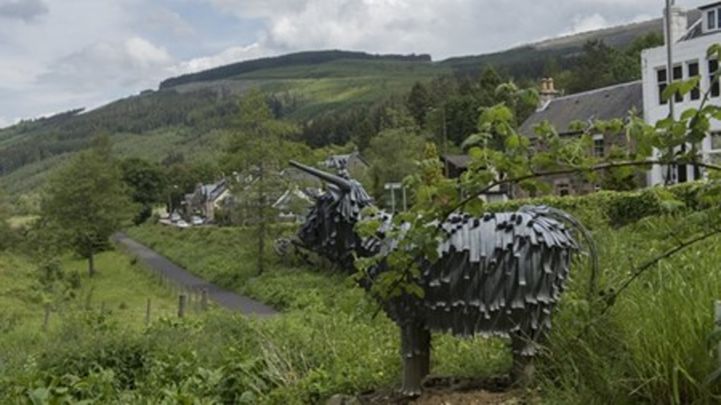
Find more information here.
2. Another example of community engagement through art and nature: Millennium Mileposts, all across the United Kingdom
The Millennium Mileposts help people navigate the National Cycle Network. They are cast-iron sculptures that were inaugurated in the year 2000, and they symbolise freedom and diversity on the National Cycle Network. The Millennium Mileposts follow four main designs, two of which were inspired by elements of the nature and the cycle paths: a tree with relief imagery of fossils and the tracks made in the landscapes by cyclists.
Millennium Mileposts can be considered Land Art as they are placed in the natural environment and they are symbolic of the connexion between people (in this case, cyclists) and nature, thus calling passing travellers to meditate on their relationship with the surrounding landscape.
Members of local communities are encouraged to spruce up a milestone in their area by brushing off dirt, cutting off vegetation or removing graffiti. This involvement encouraged people to get connected with the cycle path and the landscape and to focus on the journey, including in rural areas. Millennium Mileposts can be found along all EuroVelo routes in the United Kingdom.
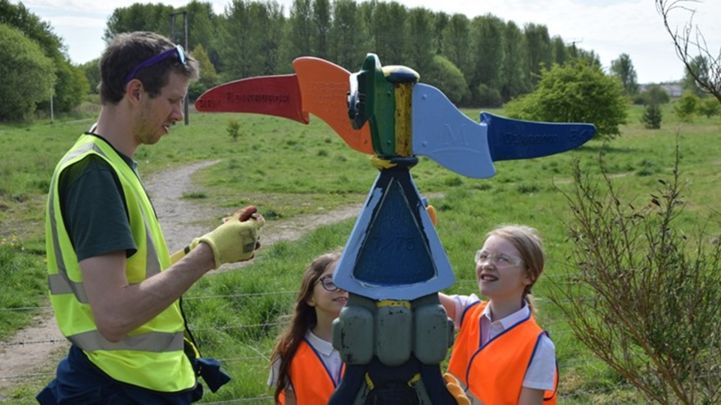
Find more information here.
3. Art Trails on the National Cycle Network: Tarka Trail, part of EuroVelo 1 – Atlantic Coast Route in Devon
In many places across the National Cycle Network, public artworks can be spotted and admired. They often refer to the history of the region, blending landscapes and the cultures that shape them in original sculptures or functional art.
One example is the Tarka Trail, a 50-km path starting in the pretty seaside village of Brauton, in the very south of England. It continues along the banks of the River Taw, reaching EuroVelo 1 at Barnstaple. The Tarka Trail then follows the EuroVelo itinerary up the Torridge Estuary and down along an old tramway route, leading to the beautiful town of Great Torrington and then across the river to the railway, where the trail ends at Meeth.
The route is flat and traffic-free, making it perfect for families. Along this trail, 30 functional artworks are to be found, designed and created by eight artists especially for the route: beautiful benches, shelters, and a series of animal seats, connected to the many wildlife habitats that can be experienced on the road.
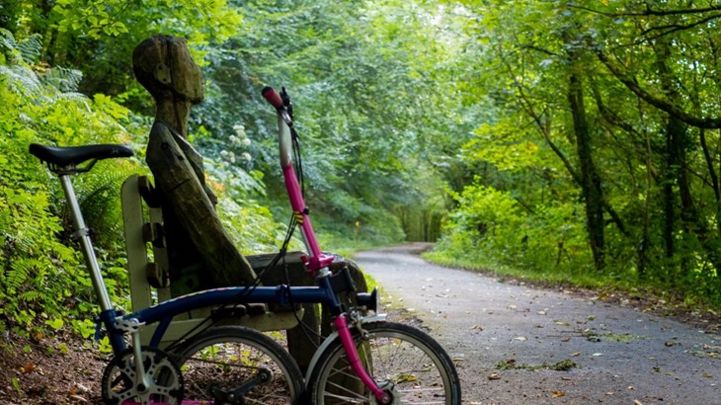
Find more information here and here.
4. Art Trails on the National Cycle Network: Water Rail Way, part of EuroVelo 12 – North Sea Cycle Route in Lincolnshire
Starting in Lincoln, the 25-km Water Rail Way goes alongside the River Witham, passing through vast fenland landscapes with long views and big skies on the way to Kirkstead Bridge. The North Sea is only a dozen of kilometres away and can be reached by keeping on EuroVelo 12 – North Sea Cycle Route.
The route features a sculpture trail commissioned by Sustrans, including viewing platforms over the banks of the River and sculptures inspired by the local environment and animals, and by the poetry of Lord Tennyson, born in Lincolnshire. This Art Trail offers an interesting blend of landscapes, nature-inspired artworks and public engagement with the beautiful platforms designed by Belgian architects Robbrecht en Daem.
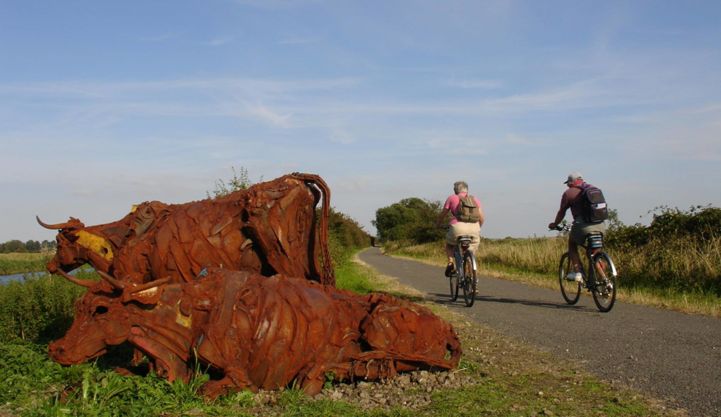
Find more information here.
5. Art Trails on the National Cycle Network: Consett and Sunderland Railway Path along EuroVelo 12 – North Sea Cycle Route in Sunderland
A little bit further along EuroVelo 12, in Sunderland, one finds the 40-km Consett & Sunderland Railway Path following a former railway line along the riverside following the Stanhope and Tyne, oldest commercial railway line in Britain, and along the marina before ending at the beach in Roker.
When the route was built in the late 1990s, Sustrans commissioned artworks along the path, including earthworks and sculptures made from recycled materials. A few examples are David Kemp’s Transformers, a pair of funny looking robots sticking from the ground, created from the scrap metal of old industrial transformers; Sally Mathews’ Beamish Shorthorns, four “cows” made from reclaimed iron that can be seen grazing along the way; and Terris Novalis by the internationally renowned artist Tony Cragg; enormous and peculiar steel sculptures representing 19th-century instruments with animal feet. Additionally, you can visit the Beamish open air museum along the route
This highly original Art Trail blending industrial heritage, recycling and the landscapes of the north of England is certainly worth a visit!
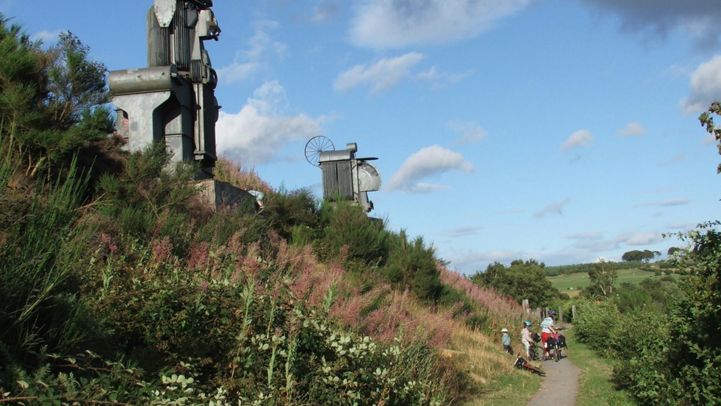
Further information here and here for more pictures.
6. Greenway “Portes Bonheur”: An open-air exhibition next to EuroVelo 5 – Via Romea (Francigena) in Alsace, France
Even though the concept is mainly popular in the United Kingdom, Land Art can also be found along cycling routes in other European countries, and it will hopefully keep being installed in more places. Here we move to Alsace in France where a short cycle path near Obernai was promoted through Land Art.
This 11-kilometre greenway, built on the old railway line from Rosheim to Saint-Nabor in Alsace, is dotted with contemporary artworks. These are the creations of Norwegian architect Reiulf Ramstad. They were thought to fit well with the surrounding landscapes, which include reservoirs of biodiversity. The greenway connects with EuroVelo 5 in the city of Rosheim, just south of Strasbourg.
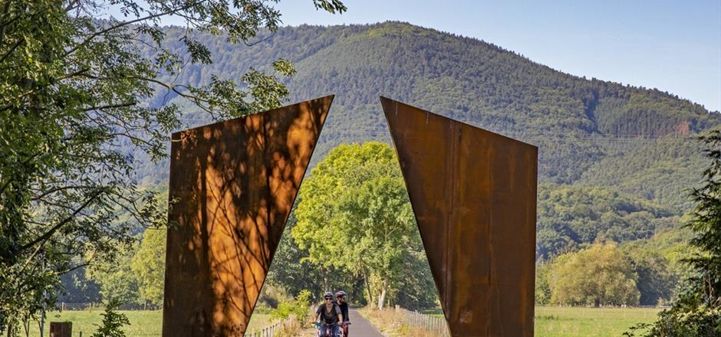
Find more informationhere.
7. Cycling through the trees in Belgium: An experience accessible via EuroVelo 19 – Meuse Cycle Route
Finally, “Cycling through the Trees” is an elevated cycle path that was built in Bosland, Belgian Limburg, allowing visitors to cycle at tree-top level, up to ten meters high. The cycle path, opened in June 2019, is 700 metres in total. This unique cycling experience attracts local cyclists as well as travellers who are curious of experiencing this connection with the forest.
This is another form of Land Art, using architecture to embed the connexion with nature into the path itself.
Find more information here.
“European Landart Network” and other synergies
The “European Landart Network (ELAN)” is an international project dating back to 2013 and supported by the Culture Programme of the European Union and the Lower Saxony region of Germany. This network was started by four partner organisations from Germany, Italy, Poland and the United Kingdom. The purpose of ELAN is to connect Land Art organisations and other stakeholders from across Europe, and to increase public visibility of Land Art in rural areas.
The ELAN website emphasises the many forms that Land Art takes across Europe and various territories, as well as the role it can play in the current challenges faced by society to become more mindful of nature and the environment. Land Art facilitates a dialogue between people art and nature by providing a new way to connect and engage with the landscape.
Land Art is a concept with a great potential in supporting the development of cycling tourism in rural areas and was studied within the framework of the BICIMUGI project, co-funded by the Interreg POCTEFA programme, as it shares the same purpose to bring life to rural areas through eco friendly activities.
Author: Florence Grégoire